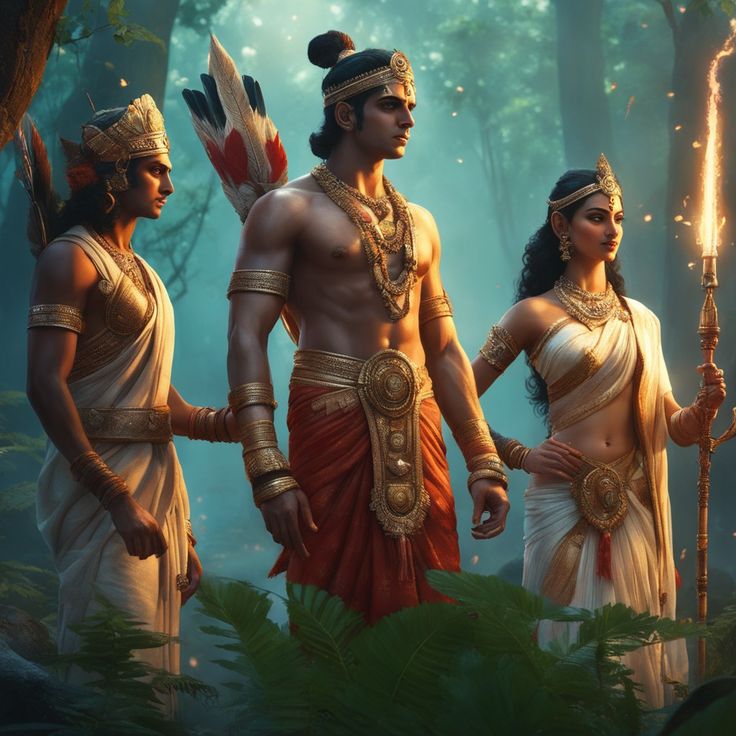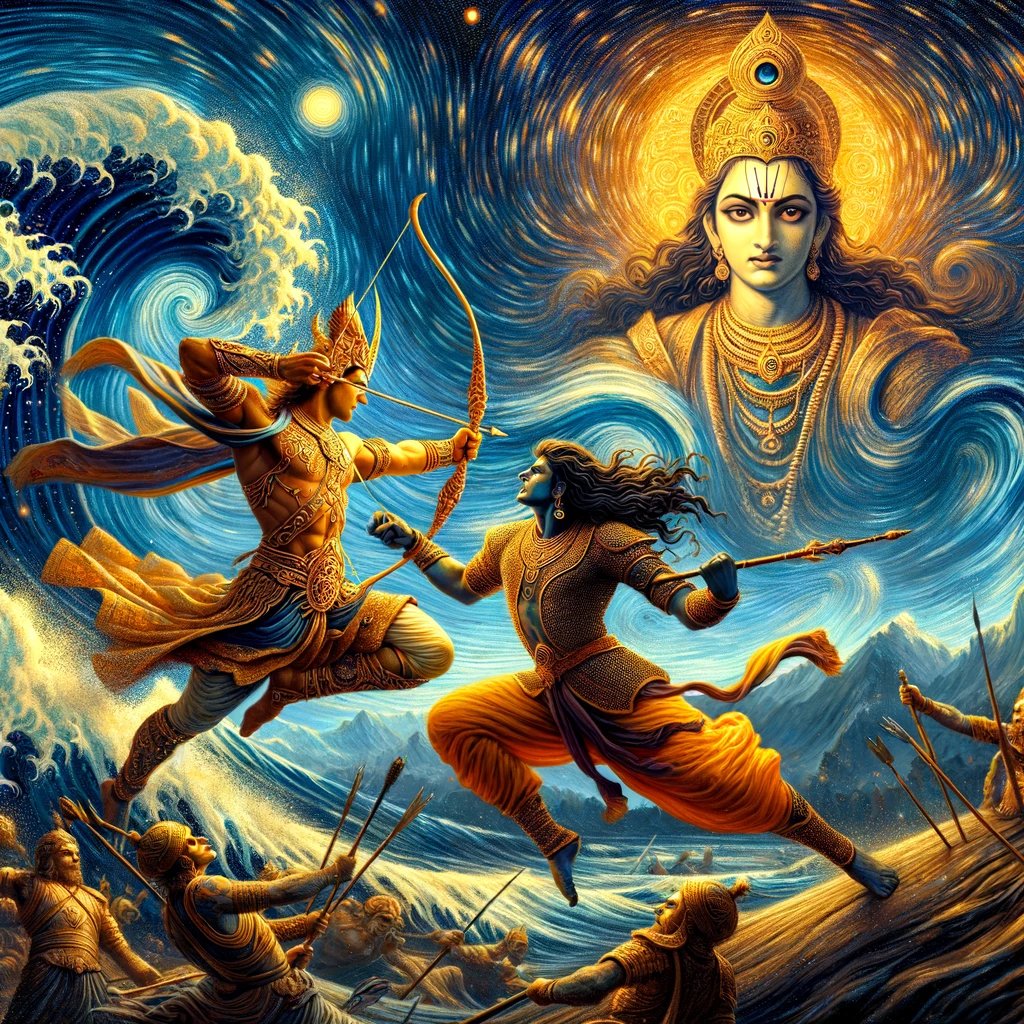After 14 yrs of exile, when Shri Ram came back to Ayodhya, a sage came to discuss Lanka War.
Ram said he KILLED raging demons Ravana & Kumbhkarna but the Sage wasn't impressed. He didn’t consider Ram 'Powerful'.
He said Ram was NOT the most powerful warrior but someone else...
Ram said he KILLED raging demons Ravana & Kumbhkarna but the Sage wasn't impressed. He didn’t consider Ram 'Powerful'.
He said Ram was NOT the most powerful warrior but someone else...

Lakshmana.
Saumitra. Shatrughna-Bandhu. Vaidehi-Nath.
Anuj. Guha-Bandhu.
Ramanuja.
Lakshmana, the loyal brother of Prabhu Shri Ram, holds a special place in Hindu history. His loyalty is the symbol of a pure soul.
This story reflects how POWERFUL Lakshman truly was...


Saumitra. Shatrughna-Bandhu. Vaidehi-Nath.
Anuj. Guha-Bandhu.
Ramanuja.
Lakshmana, the loyal brother of Prabhu Shri Ram, holds a special place in Hindu history. His loyalty is the symbol of a pure soul.
This story reflects how POWERFUL Lakshman truly was...


The story begins when Prabhu Shri Ram comes back to Ayodhya, after 14 years of exile. The entire world rejoiced on his comeback. The power of light defeated the rage of the dark. A lot of sage came to bless Shri Ram, Sita and Lakshman. 

Within these pleasantries came “Agastya Rishi”. He was considered an influential and revered sage of Hinduism. He met Shri Ram and they started discussing about how the Lanka War broke out. 

Lord Ram explained the entirety of the epic that took place in his journey in those 14 years. How he met allies like Sugreev and the Vaynar Sena (Monkey Army) and how they travelled to reach and kill the demons that were terrorising the world. 

Shri Ram told Agastya Rishi about how he killed raging demon Kings like Ravana and Kumbhakarna, and how Lakshmana killed many powerful asuras like Indrajit and Atikayya.




That’s when Agastya Rishi said to Ram that it’s true “Ravana and Kumbhakarna” were very brave & fierce, but still weren’t considered the GREATEST ASURA. 

The greatest asura of that time was Meghnad (Indrajit). Meghnad was Ravana’s son. Meghnad fought Devraj Indra in heaven, tied him and brought him to Lanka. Indra was freed when Brahma asked Meghnad to leave him. 

The one who KILLS the most powerful asura (demon) is considered the greatest warrior, so it’s not Shri Ram who’s the most powerful but Lakshman, the greatest warrior.




Lord Rama was very happy to hear the praise of his brother Lakshman's bravery & strength from Agastya Rishi. But Shri Ram’s curiosity grew deeper.
He thought “Why Agastya Rishi is saying that Killing Indrajit (Meghnad) was more difficult than Ravana”


He thought “Why Agastya Rishi is saying that Killing Indrajit (Meghnad) was more difficult than Ravana”


To quench the curiosity of Lord Rama, Agastya Rishi narrated the story of Indrajit and that Indrajit became the supreme asura of all demons because he had a boon/blessing that he could only be killed by someone:
- who hasn’t slept for 12 years.
- who hasn't seen a woman’s face for 12 years.
- who hasn’t eaten anything for 12 years.
- who hasn’t slept for 12 years.
- who hasn't seen a woman’s face for 12 years.
- who hasn’t eaten anything for 12 years.

Hearing the story Lord Ram asked Agastya Rishi, "I used to give fruits and flowers to Lakshman’s regularly for 14 years during my time in the exile. I lived in a hut with Sita, and there was Lakshmana in another cottage beside our hut, then how he had not even seen the face of Sita and had not slept for 12 years, how is this possible?"



Lakshman was also known as Gudakesh, the one who has won over the sleep cycle. Lakshman did not sleep for the entire period of the exile of 14 years to protect Shri Ram and Maa Sita. And this breaks the first boon given to Asura Meghnad (Indrajit).
When the goddess of sleep appeared before Lakshman on the first night of their exile in the forests and when Shri Ram and Maa Sita were asleep, Lakshman requested the goddess to give him no sleep for the entire 14 years, so that he could be awake to protect his beloved brother and Sita.
The goddess was impressed by this and granted the boon on the condition that someone else have to bear his sleep. At Lakshman's request, the goddess visited his wife Urmila, sister of Sita. Urmila agreed to share her husband's loss of sleep and thus slept for an entire 14 years.
When the goddess of sleep appeared before Lakshman on the first night of their exile in the forests and when Shri Ram and Maa Sita were asleep, Lakshman requested the goddess to give him no sleep for the entire 14 years, so that he could be awake to protect his beloved brother and Sita.
The goddess was impressed by this and granted the boon on the condition that someone else have to bear his sleep. At Lakshman's request, the goddess visited his wife Urmila, sister of Sita. Urmila agreed to share her husband's loss of sleep and thus slept for an entire 14 years.

Listening to Agastya Rishi’s story, Lakshman intervened and added: Sugriva asked us to identify Maa Sita by showing her jewellery. I did not recognize any jewellery except ‘Nupur’ on her feet, because I never looked at her. When Shri Ram and Maa Sita used to sleep in a hut, I used to guard outside all night. When sleep tried to capture my eyes, I had blocked my eyes with my arrows".

Lastly, Lakshman talked & told Lord Ram about being hungry for 12 years. “Shri Ram, you used to do 3 parts of the fruits and flowers that we used to bring every day for 12 years. You used to tell me by giving a portion — “Keep this fruit Lakshman”, You never asked me to EAT the fruit - then how can I eat it without your permission?





This is highlighted in the narration of the epic that in the great battle in Lanka, Lakshman was struck down by Indrajit’s arrow. His revival by the Sanjeevani herb brought by Hanuman ji is also a pivotal moment in the Ramayana, his dedication to saving Ram and defeating DEATH.




On hearing these things of Lakshman, Prabhu Shri Ram embraced him & held him closely. Lakshmana’s devotion to Rama was complete and selfless. Agastya Rishi saw this as a sign of immense inner strength and spiritual power. Agastya Rishi recognized Lakshmana’s ability to endure hardships and his willingness to sacrifice personal comfort for Lord Rama’s sake. His constant vigilance and readiness to protect Rama and Sita were seen as marks of extraordinary strength.

This was the reason that due to these harsh vows, he could endure any herculean task and KILLED the greatest asura Meghnad (Indrajit) and was considered more stronger and powerful than his brother, Prabhu Shri Ram. 

Lakshman’s story in the Ramayana is one of devotion, loyalty, and strength. His character is often celebrated for its depth and complexity. While Shri Rama is the embodiment of dharma (righteousness), Lakshman represents the ideal of service and devotion. His strength, as perceived by Agastya Rishi and depicted by Valmiki, lies in his unwavering commitment to his brother and his ability to face challenges with courage and selflessness. Lakshman’s life is a testament to the power of devotion and the strength that lies in loyalty and sacrifice, making him a revered figure in Hindu history.

Indian history is filled with such grand stories, never to be forgotten.
We @iKyu_HQ worship the delicacy of history in India and stand to flourish it to the world...
Our handKrafted documentary-style breakdowns are ready!
Experience us at ikyu.ink
We @iKyu_HQ worship the delicacy of history in India and stand to flourish it to the world...
Our handKrafted documentary-style breakdowns are ready!
Experience us at ikyu.ink
Follow @VivanVatsa for more doses of brutal breakdowns, history, research and philosophy.
https://x.com/VivanVatsa/status/1750583892237746227?s=20
• • •
Missing some Tweet in this thread? You can try to
force a refresh































